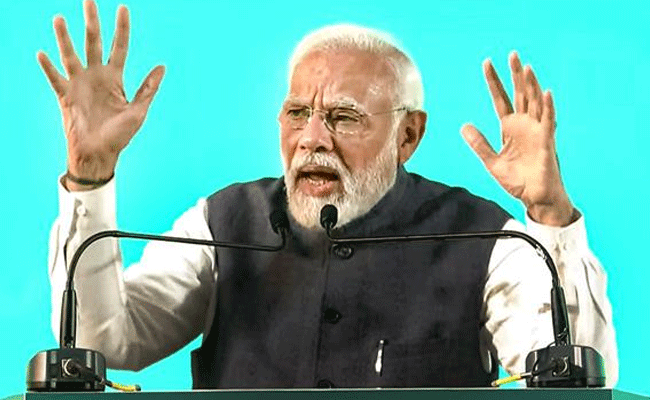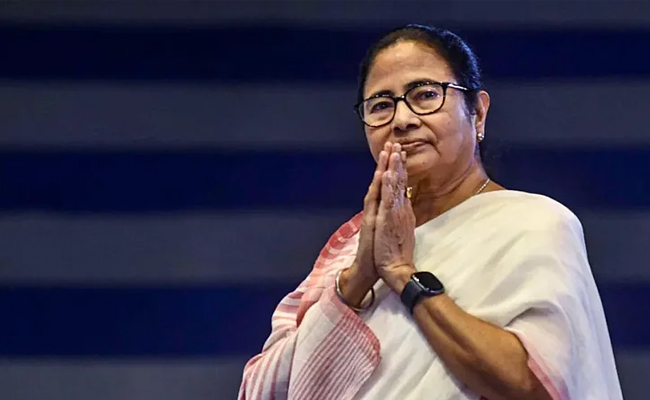Bengaluru (PTI): Prime Minister Narendra Modi on Monday showcased India's phenomenal projected growth in energy demand, stable and decisive leadership, and sustained reforms to invite global investors in the country's oil and gas exploration and new energy, including green hydrogen.
Modi in his inaugural address at India Energy Week 2023 said India is the most opportune place to invest in the energy sector at present.
The country is projected to witness the fastest growth in energy demand in the world in the next decade, the Prime Minister noted.
"I ask you to explore all opportunities connected with India's energy sector. India is the most opportune place for investment today," he said at the event, being attended by several ministers, corporate leaders and experts from different nations.
He stated that despite the global crisis, India remained a bright spot for the world in 2022 due to its internal resilience.
"Multiple factors were behind it like stable and decisive government, sustained reforms, and socio-economic empowerment at the grassroots," he said.
He also noted that over 6 lakh km of optical fibre network has been laid to provide internet facilities to the villages.
"The number of Broadband users in India has become 13 times more than it was 9 years ago, and the number of internet connections has tripled in the same period," the Prime Minister said.
He said India is working on expanding its refining capacity from 250 MMTPA to 450 MMPTA.
He also informed that India's gas pipeline network will expand to 35,000 km in the next four-five years from 22,000 km presently.
"In 2014, the length of gas pipeline in India was around 14,000 km; now it stands at over 22,000 km. Gas pipeline network in India to reach 35,000 km in the next 4-5 years. The government has reduced the no-go area for oil and gas exploration to 10 lakh square kilometres, which will unlock investment opportunities," Modi said.
On 20 per cent ethanol blending with petrol, he said India is moving towards achieving the target.
Modi also showcased the government initiatives on promoting green hydrogen in the country.
He said, "Another sector in which India is taking lead in the world is Green Hydrogen. The National Green Hydrogen Mission will give a new direction to India in the 21st century".
The Prime Minister also mentioned the recently unveiled National Hydrogen Mission, saying that it will bring investments worth Rs 8 lakh crore.
"Today, India is one of the world's leading voices in energy transition & developing new resources of energy. IMF, in their growth projections for 2023 also stated that India will remain the fastest-growing major economy," he said.
He also talked about replacing 25 per cent of grey hydrogen used in the country with green hydrogen.
Modi stated that the Budget (for 2023-34) has provided Rs 10 lakh crore for capital expenditure, which will give a boost to green hydrogen, solar power and road sectors.
The Prime Minister also recalled several initiatives taken by the government to promote green energy and make India net zero by 2070.
The Budget 2023-24 has provided Rs 35,000 crore to the petroleum and natural gas ministry for achieving the net-zero target.
India Energy Week 2023 is the first major event of G20 under India's presidency, Modi noted.
He further stated that crores of people have come out of poverty and entered the middle class due to government initiatives.
India has become the second-largest producer of mobile phones and the fourth-largest crude refiner in the world, the Prime Minister said.
Solar cooktops launched today will give a new dimension to cooking in India, he added.
Let the Truth be known. If you read VB and like VB, please be a VB Supporter and Help us deliver the Truth to one and all.
Kochi (PTI): The prosecution had "miserably" failed to prove the conspiracy charge against Dileep in the sensational 2017 actress sexual assault case, a local court has observed while citing inconsistencies and lack of sufficient evidence against the Malayalam star.
The full judgement of Ernakulam District and Principal Sessions Court Judge Honey M Varghese was released late on Friday, and has revealed the judge also pointing out at unsustainable arguments put forth by the prosecution.
"The prosecution miserably failed to prove the conspiracy between accused No.1 (Pulsar Suni) and accused No.8 (Dileep) in executing the offence against the victim," the court held.
It examined in detail, the prosecution's allegation that Dileep had hired the prime accused to sexually assault the survivor and record visuals, including close-up footage of a gold ring she was wearing, to establish her identity.
On page 1130 of the judgment, under paragraph 703, the court framed the issue as whether the prosecution's contention that NS Sunil (Pulsar Suni) recorded visuals of the gold ring worn by the victim at the time of the occurrence, so as to clearly disclose her identity, was sustainable.
The prosecution contended Dileep and Suni had planned the recording so that the actress' identity would be unmistakable, with the video of the gold ring intended to convince Dileep that the visuals were genuine.
However, the court noted that this contention was not stated in the first charge sheet and was introduced only in the second one.
As part of this claim, a gold ring was seized after the victim produced it before the police.
The court observed that multiple statements of the victim were recorded from February 18, 2017, following the incident, and that she first raised allegations against Dileep only on June 3, 2017.
Even on that day, nothing was mentioned about filming of the ring as claimed by the prosecution, the court said.
The prosecution failed to explain why the victim did not disclose this fact at the earliest available opportunities.
It further noted that although the victim had viewed the sexual assault visuals twice, she did not mention any specific recording of the gold ring on those occasions, which remained unexplained.
The court also examined the approvers' statements.
One approver told the magistrate that Dileep had instructed Pulsar Suni to record the victim's wedding ring.
The court observed that no such wedding ring was available with her at that time.
During the trial, the approver changed his version, the court said.
The Special Public Prosecutor put a leading question to the approver on whether Dileep had instructed the recording of the ring, after which he deposed that the instruction was to record it to prove the victim's identity.
The court observed that the approver changed his account to corroborate the victim's evidence.
When the same question was put to another approver, he repeated the claim during the trial but admitted he had never stated this fact before the investigating officer.
The court noted that the second approver even went to the extent of claiming Dileep had instructed the execution of the crime as the victim's engagement was over.
This showed that the evidence of the second approver regarding the shooting of the ring was untrue, as her engagement had taken place after the crime.
The court further observed that the visuals themselves clearly revealed the victim's identity and that there was no need to capture images of the ring to establish identity.
In paragraph 887, the court examined the alleged motive behind the crime and noted that in the first charge sheet, the prosecution had claimed that accused persons 1 to 6 had kidnapped the victim with the common intention of capturing nude visuals to extort money by threatening to circulate them and there was no mention about Dileep's role in it.
The court also rejected the prosecution's claim that the accused had been planning the assault on Dileep's instructions since 2013, noting that the allegation was not supported by reliable evidence.
It similarly ruled out the claim that Suni attempted to sexually assault the victim in Goa in January 2017, stating that witness statements showed no such misconduct when he served as the driver of the vehicle used by the actress there.
The court also discussed various controversies that followed Dileep's arrest and the evidence relied upon by the prosecution, ultimately finding that the case had not been proved.
Pronouning its verdict on the sensational case on December 8, the court acquitted Dileep and three others.
Later, the court sentenced six accused, including the prime accused Suni, to 20 years' rigorous imprisonment.
The assault on the multilingual actress, after the accused allegedly forced their way into her car and held it under their control for two hours on February 17, 2017, had shocked Kerala.
Pulsar Suni sexually assaulted the actress and video recorded the act with the help of the other convicted persons in the moving car.





